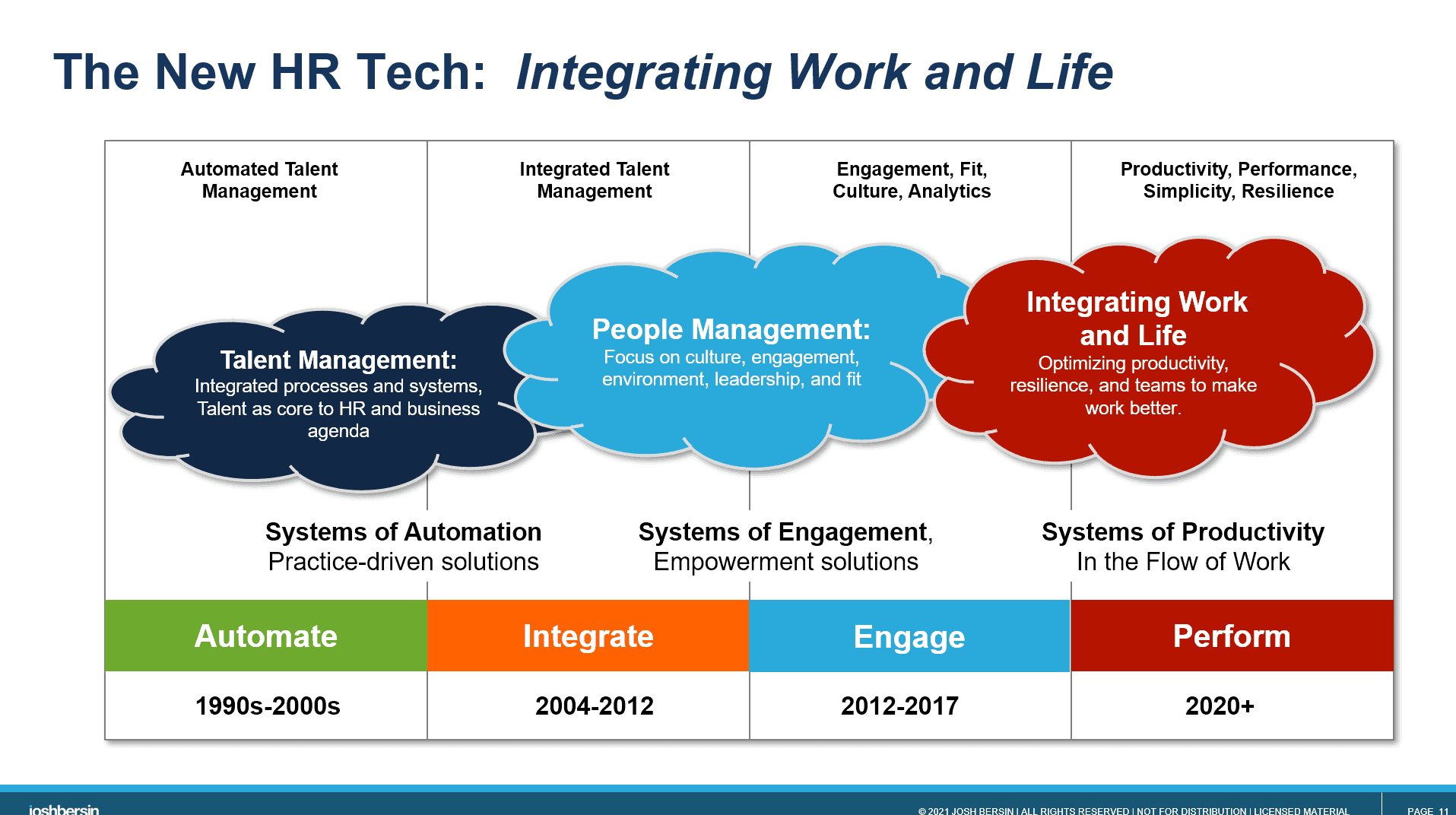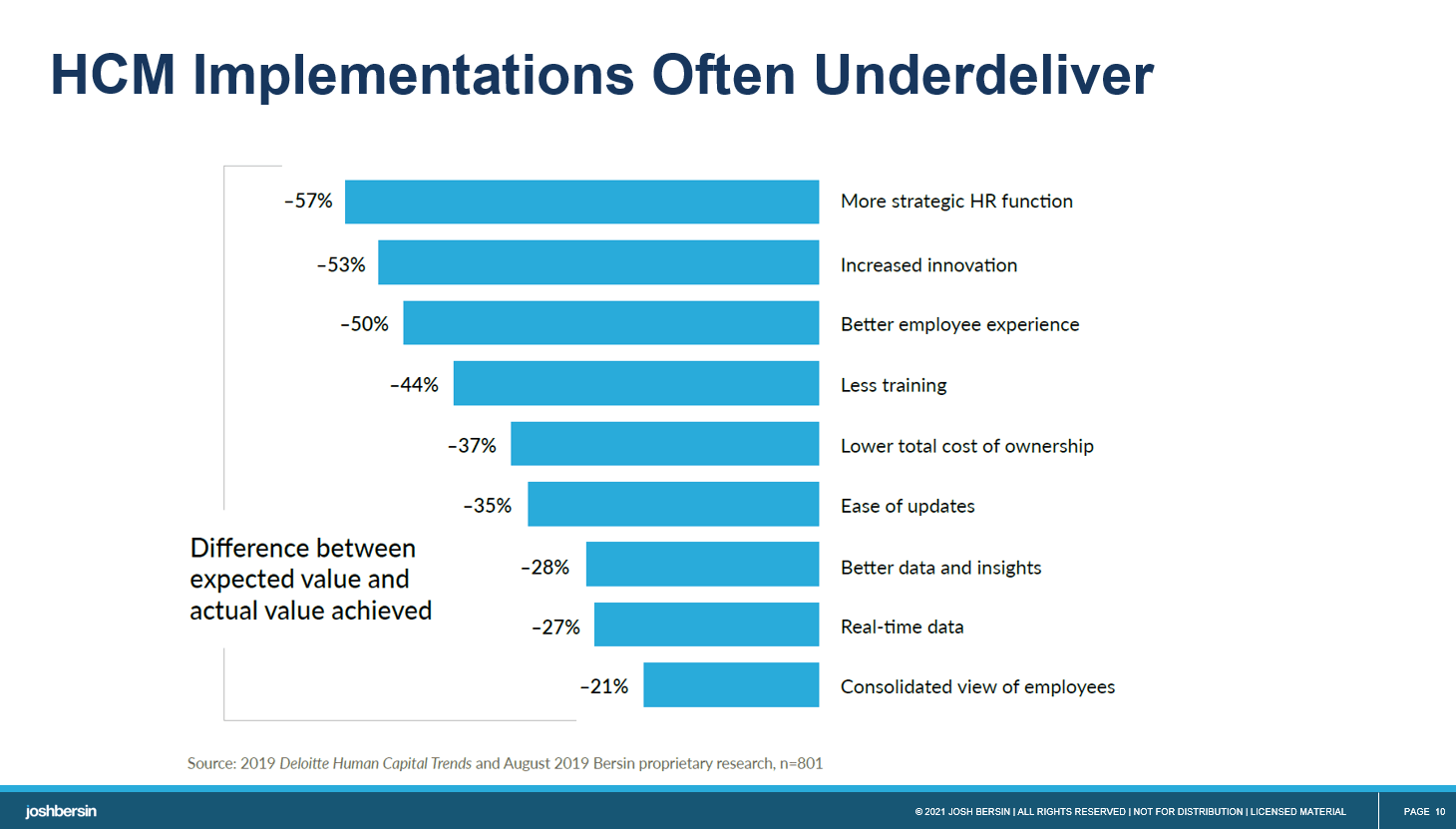Research Reveals Secrets To Success With Human Capital Management Systems
We have been studying HR technology projects for years and they can be complex and risky. Companies tend to upgrade or replace of their core HCM technology every 7-8 years and when they do it’s a massive change. Not only is it expensive and time-consuming, but these projects can interrupt business growth and take attention from the CEO, CIO, and CHRO.
Well over the last year we completed a series of large studies on HCM implementations and learned about what works. This week we’re launching this new research, HCM Excellence: The Definitive Guide, which reveals many of the secrets.
HCM Projects Are Not Implementations: They’re Transformations
Let’s start at the beginning. Why do companies change their core HR platforms every 7-8 years? One big reason: the technologies evolve and older systems hold companies back.
In the last decade we’ve gone through three big changes:
Integrated talent management: In the early 2000s these systems were designed as process automation tools. Companies bought PeopleSoft, Oracle, SuccessFactors, or Workday with the intention of automating talent management practices. Shifting investment from in-house systems, companies were relieved to buy products in the cloud and turn over the software upgrades to vendors.
Systems of engagement: In the mid-2000s vendors focused on the needs of employees, not just HR. New applications like self-service, mobile access, journey tools, and AI-enabled chatbots became available. These “experience centric” systems were intended to help employees and managers do their jobs better, so the center of gravity shifted.
Intelligent systems of work: Today we’re in the third wave: HCM systems to facilitate hybrid work, support employees working at home (or remotely), and enable HR practices in the flow of work. Today’s HCM platforms are not only transaction and employee experience systems, they’re real-time analytics systems, predictive performance tools, and employee voice systems to help employees speak up as work needs change.
 |
It would have been nice if one system survived this evolution, but software companies tend to evolve. Companies that build systems designed for one era tend to fall behind in the next. So regardless of which system you select, at some point you’re looking at a replacement.
And as this evolution points out, we have to stop thinking about HCM projects as “implementations.” They are “business transformations.” Each subsequent evolution gives you opportunities to change how your company works.
In the talent management era, for example, we organized our companies around integrated hiring and performance practices. Today, by contrast, we are enabling hybrid work, facilitating agile work and job models, and delivering intelligent productivity systems to employees.
Are Expectations Met? Often Not.
In 2018 and 2019 we asked more than 800 companies about their success with these projects and the results were underwhelming. As you can see, most buyers do feel that their project’s did not deliver as hoped. This is not to say they were a failure, but the expectations far exceed reality.
 |
Some of this is the result of vendors overselling what they do. Many vendors convince their customers their system will make their company more agile. Of course, integrated data is can definitely improve decision-making, but many of the promised improvements fall on the shoulders of your management, not the software vendor’s system.
I remember years ago talking with Bob Epstein, the founder of Sybase. He used to joke that “a legacy system is one that works.” In other words, don’t just assume that the new system will automatically be better than one you’ve been customizing for years. You have to redesign your company to use the new technology you buy.
Buying A New HCM System Is Like Buying A House
Think about a new HCM system like moving into a new house.
When you buy a new house, you expect a lot of good things to happen. You’ll have more room, you’ll gain a better layout, the closets will be bigger, and maybe the schools and neighborhood are better too.
But as everyone knows about a new house, there are always trade-offs. No house is perfect; there are roof leaks or foundation cracks you didn’t notice, and the new neighborhood has its own issues. Of course, we always love our new house, but it takes time and attention to “make it ours.”
This is what HCM implementations are like. You’re not “implementing a system” you’re “preparing to live in a new house.” So if you aren’t clear on what you want to accomplish, you may find the house unsettling.
And as with a new house, you have to paint it, furnish it, and maybe even do some remodeling.
Research Clarifies The Process
The research we’re launching today (supported by Tata Consultancy Services) is the culmination of many years of work. We interviewed hundreds of companies implementing many different HR systems. In 2018 and 2019 we conducted a large study of “why adoption fails” with Unleash. And in our ongoing work at Deloitte, PwC, and other consulting firms we worked on projects of all shapes and sizes.
Here is what we learned.
1/ Clearly Define Your Strategic Goals.
The first goal is to decide what outcomes you want to achieve. Many clients buy these systems with a “rip and replace” strategy and they simply want a newer system that’s less expensive to operate or easier to use. This is a naive expectation: new HCM platforms have enormously different capabilities, and each is immature in some areas.
If you’re a fast-growing company, for example, you may be focused on recruiting and internal mobility. So you’ll want your implementation to focus on these areas. If you’re going through a business transformation, you may want to focus on growth, career, and self-service. So you’ll focus your energy on automation, skills, and learning.
In some cases, the HCM project is designed to replace a bunch of old systems. So here you’ll need to focus on payroll, operations, and data management.
Depending on your business focus, each implementation may go differently. And as you’ll see in the report, if you aren’t focused on employees first, you’re going to have some problems.
2/ Invest in Integration and Simplicity.
The second priority is to simplify the architecture, eliminate as many standalone systems as possible, and focus on data integration.
We just finished a project with a company that has more than 18 core HR systems and they own some of the most advanced HR Tech in the world. Yet their data quality is poor, employees don’t trust the system for accuracy, and the systems are hard to use.
How did they get into this bind? They did not focus on architecture, integration, and simplicity. A new HCM system is not an opportunity to “buy more stuff,” it’s an opportunity to “get rid of old stuff.” And this means being relentless about minimizing the number of systems you have, creating a clear roadmap for each component, and simplifying the systems architecture.
And data and security integration are essential. This is your chance to decide what data goes where and integrate systems so you don’t have islands of inconsistent data. (Our course on People Analytics will help.)
3/ Invest in Project Governance And Adequate Resources.
These are big projects. You’re going to need the CFO, CIO, and CHRO as sponsors, and you may need help from facilities, security, and others. There must be an ongoing governance process for the system, and one with strong project leaders, budgetary oversight, and a relentless focus on execution.
Consulting firms are good at managing these projects, but they are not the ones to make decisions. This is your house and you’re going to live in it. So every decision you make about what windows to paint, where to put furniture, and what color to paint the walls – all belong with you. And these teams are often pretty big. You’ll need a series of cascading teams to make process decisions in the system, and each team should include stakeholders from around the world.
Invest in an experienced leadership team. If you’ve never implemented a system like this in the past, hire someone who has done it. There are lots of “gotchas” and you can’t rely on the integrator to know everything.
Our research actually found that the projects that failed all had teams that reorganized several times. You need to motivate the team to “stick with the project” and feel good about their goal (the GE case study explains this in some detail.)
4/ Carefully Manage Data.
One of the biggest benefits of a new system is integrated and accurate data. So you need to make this happen.
Most HCM implementations touch payroll and payroll is a complex application. Not only do payroll systems vary by country, but there is a myriad of payroll providers, legacy systems, and compensation and benefits systems to consider. World-class HCM implementations build a global data dictionary, focus on data quality, and invest in systems integration.
Remember that lots of HR data are entered by individuals, so the HCM system has to have data quality panels and tools to make sure the data stays accurate.
And in this era, these are “systems of intelligence” which get smarter over time. So you’re going to start with a “naked system” that doesn’t have a lot of smarts, and then you’ll need a team to “train” the system over time.
5/ Center Your Work On Employee Experience.
The most important part of all is to focus on employees, not the system.
If employees don’t find the system easy to use, it won’t be adopted well. HR teams can spend months working through process maps and process harmonization, but they don’t think enough about Employee Personas, Employee Journeys, and the day-to-day use cases for employees at all levels.
This means segmenting employees into personas, creating journey maps and design thinking sessions, and co-designing with the business. Consultants (like TCS) have hundreds of these journeys already designed, so you can look them over and customize them for your company.
As you’ll read about in the report, GE, Deutsche Telecom, and many others make Design Thinking the core of a new system. They create detailed employee personas, embrace user-centric design, and they implement solutions in an iterative way.
 |
There Is A Maturity Model To These Projects
Some people just “move in” to a new house and live with it as-is, while others go through a total remodel. Similarly, companies adopt their HCM systems in different ways.
 |
Our research found that the most successful implementations use the HCM platform as a tool for transformation. They don’t just “replace the old with the new.” They use the capabilities of the new platform (and its ecosystem) to transform HR, work, and the employee experience.
You can download the research here – if you’d like help with your HCM technology strategy, please give us a call.
Additional Resources
The Definitive Guide to HCM Excellence
HR Technology: The Dirty Little Secret


